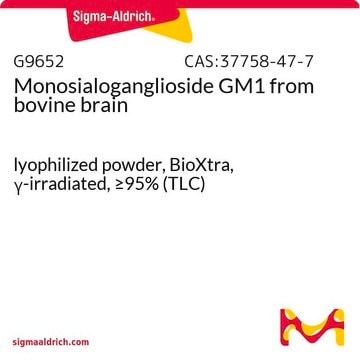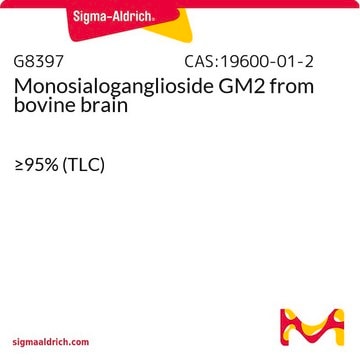G7641
Monosialoganglioside GM1 from bovine brain
≥95% (TLC), lyophilized powder, sialoglycolipid
Sinónimos:
Ganglioside GM1, monosialo
About This Item
Productos recomendados
product name
Monosialoganglioside GM1 from bovine brain, ≥95%, lyophilized powder
Nivel de calidad
Análisis
≥95%
formulario
lyophilized powder
temp. de almacenamiento
−20°C
cadena SMILES
CCCCCCCCCCCCCCCCCCCC(=O)N[C@H](CO[C@@H]1O[C@H](CO)[C@@H](O[C@@H]2O[C@H](CO)[C@H](O[C@@H]3O[C@H](CO)[C@H](O)[C@H](O[C@@H]4O[C@H](CO)[C@H](O)[C@H](O)[C@H]4O)[C@H]3NC(C)=O)[C@H](O[C@@]5(C[C@H](O)[C@@H](NC(C)=O)[C@@H](O5)[C@H](O)[C@H](O)CO)C(O)=O)[C@H]2O)[C@H](O)[C@H]1O)[C@@H](O)\C=C\CCCCCCCCCCCCCCC
InChI
1S/C73H131N3O31/c1-5-7-9-11-13-15-17-19-20-22-24-26-28-30-32-34-52(86)76-44(45(83)33-31-29-27-25-23-21-18-16-14-12-10-8-6-2)40-99-69-61(93)59(91)63(50(38-79)102-69)104-71-62(94)67(98-41-47(85)55(87)66-53(74-42(3)81)46(84)35-73(97,107-66)72(95)96)64(51(39-80)103-71)105-68-54(75-43(4)82)65(57(89)49(37-78)100-68)106-70-60(92)58(90)56(88)48(36-77)101-70/h31,33,44-51,53-71,77-80,83-85,87-94,97H,5-30,32,34-41H2,1-4H3,(H,74,81)(H,75,82)(H,76,86)(H,95,96)/b33-31+/t44?,45?,46-,47?,48+,49+,50+,51+,53+,54+,55?,56-,57-,58-,59+,60+,61+,62+,63+,64-,65+,66+,67+,68-,69+,70-,71-,73-/m0/s1
Clave InChI
CNLVNZJJSHZYAS-ALSOZVJRSA-N
¿Está buscando productos similares? Visita Guía de comparación de productos
Amino Acid Sequence
Descripción general
Aplicación
- in GM1 capture enzyme-linked immunosorbent assay (ELISA)
- for the quantification of cholera toxin B subunit (CTB)-p277 protein accumulation
- for Escherichia coli heat-labile enterotoxin (LT-B) detection
- to determine the affinity of the GM1-ganglioside receptor for the plant-derived Escherichia coli heat-labile toxin LTK63 protein
Acciones bioquímicas o fisiológicas
Código de clase de almacenamiento
11 - Combustible Solids
Clase de riesgo para el agua (WGK)
WGK 3
Punto de inflamabilidad (°F)
Not applicable
Punto de inflamabilidad (°C)
Not applicable
Equipo de protección personal
Eyeshields, Gloves, type N95 (US)
Certificados de análisis (COA)
Busque Certificados de análisis (COA) introduciendo el número de lote del producto. Los números de lote se encuentran en la etiqueta del producto después de las palabras «Lot» o «Batch»
¿Ya tiene este producto?
Encuentre la documentación para los productos que ha comprado recientemente en la Biblioteca de documentos.
Los clientes también vieron
Artículos
Discover Bioactive Small Molecules for Lipid Signaling Research
Nuestro equipo de científicos tiene experiencia en todas las áreas de investigación: Ciencias de la vida, Ciencia de los materiales, Síntesis química, Cromatografía, Analítica y muchas otras.
Póngase en contacto con el Servicio técnico














